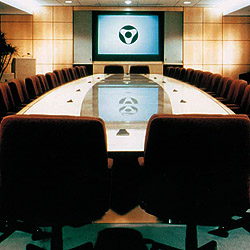
The sensitivity of the microphone should be in the medium-to-high range since the sound source (speaking voice) is not excessively loud and is picked up from a slight distance. Again, this is most easily accomplished by a condenser type.
The choice of physical design for a lectern microphone must blend performance with actual use. The most effective approach is a gooseneck-mounted type, which places the microphone close to the sound source and away from both the reflective surface of the lectern and noise from the handling of materials on it.
Another approach is the use of a boundary microphone on the lectern surface, but this method is limited by lectern design and by the potential for noise pickup.
As mentioned above, the desired physical design may also suggest the operating principle. The most effective small gooseneck or boundary styles are condensers.
The ideal placement of a lectern microphone is 6 to 12 inches away from the mouth, and aimed toward the mouth. This will give good pickup of the voice and minimum pickup of other sources.
Also, locating the microphone a few inches off-center will reduce breath noise that might occur directly in front of the mouth. It is not recommended that two microphones be used on a lectern as comb filtering interference is likely to occur.
Proper operation of the microphone requires correct connection to the sound system with quality cables and connectors, and correct phantom power if a condenser is used. Use a shock mount to control mechanical noise from the lectern itself.
Some microphones are equipped with low-cut or low-end roll-off filters, which may further reduce low frequency mechanical or acoustic noise.
Goosenecks should be quiet when flexed. It is strongly recommended that a pop filter be placed on the microphone to control explosive breath sounds, especially when using miniature condenser types.
Good technique for lectern microphone use includes:
•—Do adjust the microphone position for proper placement.
•—Do maintain a fairly constant distance of 6 to 12 inches.
•—Don’t blow on microphone, or touch microphone or mount when in use.
•—Don’t make excess noise with materials on lectern.
•—Do speak in a clear and well-modulated voice.
Meeting Table
The desired sound source at a meeting table is a speaking voice. Undesired sounds may include direct sound, such as an audience or loudspeakers, and ambient noise sources such as building noise or the meeting participants. A boundary microphone is the physical design best suited to this application.
It will minimize interference effects due to reflections from the table surface and will also result in increased microphone sensitivity. A condenser type is the most effective for this configuration, due to its high performance and small size.

